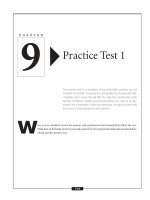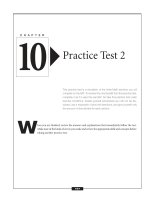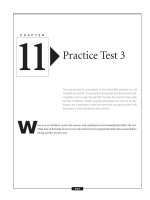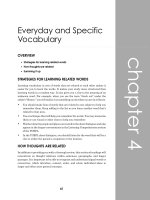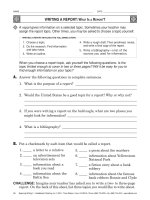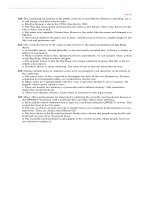SAT math essentials part 8 ppt
Bạn đang xem bản rút gọn của tài liệu. Xem và tải ngay bản đầy đủ của tài liệu tại đây (331.3 KB, 20 trang )
Practice Question
A rectangle has a perimeter of 42 and two sides of length 10. What is the length of the other two sides?
a. 10
b. 11
c. 22
d. 32
e. 52
Answer
b. You know that the rectangle has two sides of length 10. You also know that the other two sides of the
rectangle are equal because rectangles have two sets of equal sides. Draw a picture to help you better
understand:
Based on the figure, you know that the perimeter is 10 ϩ 10 ϩ x ϩ x. So set up an equation and solve
for x:
10 ϩ 10 ϩ x ϩ x ϭ 42
20 ϩ 2x ϭ 42
20 ϩ 2x Ϫ 20 ϭ 42 Ϫ 20
2x ϭ 22
ᎏ
2
2
x
ᎏ
ϭ
ᎏ
2
2
2
ᎏ
x ϭ 11
Therefore, we know that the length of the other two sides of the rectangle is 11.
Practice Question
The height of a triangular fence is 3 meters less than its base. The base of the fence is 7 meters. What is the
area of the fence in square meters?
a. 4
b. 10
c. 14
d. 21
e. 28
Answer
c. Draw a picture to help you better understand the problem. The triangle has a base of 7 meters. The
height is three meters less than the base (7 Ϫ 3 ϭ 4), so the height is 4 meters:
4
7
10 10
x
x
–GEOMETRY REVIEW–
135
The formula for the area of a triangle is
ᎏ
1
2
ᎏ
(base)(height):
A ϭ
ᎏ
1
2
ᎏ
bh
A ϭ
ᎏ
1
2
ᎏ
(7)(4)
A ϭ
ᎏ
1
2
ᎏ
(28)
A ϭ 14
The area of the triangular wall is 14 square meters.
Practice Question
A circular cylinder has a radius of 3 and a height of 5. Ms. Stewart wants to build a rectangular solid with a
volume as close as possible to the cylinder. Which of the following rectangular solids has dimension closest
to that of the circular cylinder?
a. 3 ϫ 3 ϫ 5
b. 3 ϫ 5 ϫ 5
c. 2 ϫ 5 ϫ 9
d. 3 ϫ 5 ϫ 9
e. 5 ϫ 5 ϫ 9
Answer
d. First determine the approximate volume of the cylinder. The formula for the volume of a cylinder is V
ϭ πr
2
h. (Because the question requires only an approximation, use π≈3 to simplify your calculation.)
V ϭ πr
2
h
V ≈ (3)(3
2
)(5)
V ≈ (3)(9)(5)
V ≈ (27)(5)
V ≈ 135
Now determine the answer choice with dimensions that produce a volume closest to 135:
Answer choice a: 3 ϫ 3 ϫ 5 ϭ 9 ϫ 5 ϭ 45
Answer choice b: 3 ϫ 5 ϫ 5 ϭ 15 ϫ 5 ϭ 75
Answer choice c: 2 ϫ 5 ϫ 9 ϭ 10 ϫ 9 ϭ 90
Answer choice d: 3 ϫ 5 ϫ 9 ϭ 15 ϫ 9 ϭ 135
Answer choice e: 5 ϫ 5 ϫ 9 ϭ 25 ϫ 9 ϭ 225
Answer choice d equals 135, which is the same as the approximate volume of the cylinder.
–GEOMETRY REVIEW–
136
Practice Question
Mr. Suarez painted a circle with a radius of 6. Ms. Stone painted a circle with a radius of 12. How much
greater is the circumference of Ms. Stone’s circle than Mr. Suarez’s circle?
a. 3π
b. 6π
c. 12π
d. 108π
e. 216π
Answer
c. You must determine the circumferences of the two circles and then subtract. The formula for the circum-
ference of a circle is C ϭ 2πr.
Mr. Suarez’s circle has a radius of 6:
C ϭ 2πr
C ϭ 2π(6)
C ϭ 12π
Ms. Stone’s circle has a radius of 12:
C ϭ 2πr
C ϭ 2π(12)
C ϭ 24π
Now subtract:
24π Ϫ 12π ϭ 12π
The circumference of Ms. Stone’s circle is 12π greater than Mr. Suarez’s circle.
Coordinate Geometry
A coordinate plane is a grid divided into four quadrants by both a horizontal x-axis and a vertical y-axis. Coor-
dinate points can be located on the grid using ordered pairs. Ordered pairs are given in the form of (x,y). The x
represents the location of the point on the horizontal x-axis, and the y represents the location of the point on the
vertical y-axis. The x-axis and y-axis intersect at the origin, which is coordinate point (0,0).
Graphing Ordered Pairs
The x-coordinate is listed first in the ordered pair, and it tells you how many units to move to either the left or
the right. If the x-coordinate is positive, move from the origin to the right. If the x-coordinate is negative, move
from the origin to the left.
–GEOMETRY REVIEW–
137
The y-coordinate is listed second and tells you how many units to move up or down. If the y-coordinate is
positive, move up from the origin. If the y-coordinate is negative, move down from the origin.
Example
Graph the following points:
(0,0) (3,5) (3,Ϫ5) (Ϫ3,5) (Ϫ3,Ϫ5)
Notice that the graph is broken up into four quadrants with one point plotted in each one. The chart below
indicates which quadrants contain which ordered pairs based on their signs:
POINT SIGNS OF COORDINATES QUADRANT
(3,5) (+,+) I
(–3,5) (–,+) II
(–3,–5) (–,–) III
(3,–5) (+,–) IV
(Ϫ3,5)
(0,0)
Quadrant
II
Quadrant
I
Quadrant
III
Quadrant
IV
(3,5)
(Ϫ3,Ϫ5) (3,Ϫ5)
–GEOMETRY REVIEW–
138
Practice Question
Which of the five points on the graph above has coordinates (x,y) such that x ϩ y ϭ 1?
a. A
b. B
c. C
d. D
e. E
Answer
d. You must determine the coordinates of each point and then add them:
A (2,Ϫ4): 2 ϩ (Ϫ4) ϭϪ2
B (Ϫ1,1): Ϫ1 ϩ 1 ϭ 0
C (Ϫ2,Ϫ4): Ϫ2 ϩ (Ϫ4) ϭϪ6
D (3,Ϫ2): 3 ϩ (Ϫ2) ϭ 1
E (4,3): 4 ϩ 3 ϭ 7
Point D is the point with coordinates (x,y) such that x ϩ y ϭ 1.
Lengths of Horizontal and Vertical Segments
The length of a horizontal or a vertical segment on the coordinate plane can be found by taking the absolute value
of the difference between the two coordinates, which are different for the two points.
A
E
B
D
1
C
1
–GEOMETRY REVIEW–
139
Example
Find the length of A
ෆ
B
ෆ
and B
ෆ
C
ෆ
.
A
ෆ
B
ෆ
is parallel to the y-axis, so subtract the absolute value of the y-coordinates of its endpoints to find its length:
A
ෆ
B
ෆ
ϭ |3 Ϫ (Ϫ2)|
A
ෆ
B
ෆ
ϭ |3 ϩ 2|
A
ෆ
B
ෆ
ϭ |5|
A
ෆ
B
ෆ
ϭ 5
B
ෆ
C
ෆ
is parallel to the x-axis, so subtract the absolute value of the x-coordinates of its endpoints to find its length:
B
ෆ
C
ෆ
ϭ |Ϫ3 Ϫ 3|
B
ෆ
C
ෆ
ϭ |Ϫ6|
B
ෆ
C
ෆ
ϭ 6
Practice Question
A
B
C
(Ϫ2,7)
(Ϫ2,Ϫ6)
(5,Ϫ6)
A
B
C
(Ϫ3,3)
(Ϫ3,Ϫ2) (3,Ϫ2)
–GEOMETRY REVIEW–
140
What is the sum of the length of A
ෆ
B
ෆ
and the length of B
ෆ
C
ෆ
?
a. 6
b. 7
c. 13
d. 16
e. 20
Answer
e. A
ෆ
B
ෆ
is parallel to the y-axis, so subtract the absolute value of the y-coordinates of its endpoints to find
its length:
A
ෆ
B
ෆ
ϭ |7 Ϫ (Ϫ6)|
A
ෆ
B
ෆ
ϭ |7 ϩ 6|
A
ෆ
B
ෆ
ϭ |13|
A
ෆ
B
ෆ
ϭ 13
B
ෆ
C
ෆ
is parallel to the x-axis, so subtract the absolute value of the x-coordinates of its endpoints to find
its length:
B
ෆ
C
ෆ
ϭ |5 Ϫ (Ϫ2)|
B
ෆ
C
ෆ
ϭ |5 ϩ 2|
B
ෆ
C
ෆ
ϭ |7|
B
ෆ
C
ෆ
ϭ 7
Now add the two lengths: 7 ϩ 13 ϭ 20.
Distance between Coordinate Points
To find the distance between two points, use this variation of the Pythagorean theorem:
d ϭ ͙(x
2
Ϫ x
ෆ
1
)
2
ϩ (
ෆ
y
2
Ϫ y
1
ෆ
)
2
ෆ
Example
Find the distance between points (2,Ϫ4) and (Ϫ3,Ϫ4).
C
(2,4)
(Ϫ3,Ϫ4)
(5,Ϫ6)
–GEOMETRY REVIEW–
141
The two points in this problem are (2,Ϫ4) and (Ϫ3,Ϫ4).
x
1
ϭ 2
x
2
ϭϪ3
y
1
ϭϪ4
y
2
ϭϪ4
Plug in the points into the formula:
d ϭ ͙(x
2
Ϫ x
ෆ
1
)
2
ϩ (
ෆ
y
2
Ϫ y
1
ෆ
)
2
ෆ
d ϭ ͙(Ϫ3 Ϫ
ෆ
2)
2
ϩ
ෆ
(Ϫ4 Ϫ
ෆ
(Ϫ4))
ෆ
2
ෆ
d ϭ ͙(Ϫ3 Ϫ
ෆ
2)
2
ϩ
ෆ
(Ϫ4 ϩ
ෆ
4)
2
ෆ
d ϭ ͙(Ϫ5)
2
ෆ
ϩ (0)
2
ෆ
d ϭ ͙25
ෆ
d ϭ 5
The distance is 5.
Practice Question
What is the distance between the two points shown in the figure above?
a. ͙20
ෆ
b. 6
c. 10
d. 2͙34
ෆ
e. 4͙34
ෆ
(1,Ϫ4)
(Ϫ5,6)
–GEOMETRY REVIEW–
142
Answer
d. To find the distance between two points, use the following formula:
d ϭ ͙(x
2
Ϫ x
ෆ
1
)
2
ϩ (
ෆ
y
2
Ϫ y
1
ෆ
)
2
ෆ
The two points in this problem are (Ϫ5,6) and (1,Ϫ4).
x
1
ϭϪ5
x
2
ϭ 1
y
1
ϭ 6
y
2
ϭϪ4
Plug the points into the formula:
d ϭ ͙(x
2
Ϫ x
ෆ
1
)
2
ϩ (
ෆ
y
2
Ϫ y
1
ෆ
)
2
ෆ
d ϭ ͙(1 Ϫ (Ϫ
ෆ
5))
2
ϩ
ෆ
(Ϫ4 Ϫ
ෆ
6)
2
ෆ
d ϭ ͙(1 ϩ 5
ෆ
)
2
ϩ (Ϫ
ෆ
10)
2
ෆ
d ϭ ͙(6)
2
ϩ
ෆ
(Ϫ10)
ෆ
2
ෆ
d ϭ ͙36 ϩ 1
ෆ
00
ෆ
d ϭ ͙136
ෆ
d ϭ ͙4 ϫ 34
ෆ
d ϭ ͙34
ෆ
The distance is 2͙34
ෆ
.
Midpoint
A midpoint is the point at the exact middle of a line segment. To find the midpoint of a segment on the coordi-
nate plane, use the following formulas:
Midpoint x ϭ
ᎏ
x
1
ϩ
2
x
2
ᎏ
Midpoint y ϭ
ᎏ
y
1
ϩ
2
y
2
ᎏ
Example
Find the midpoint of A
ෆ
B
ෆ
.
B
A
Midpoint
(5,Ϫ5)
(Ϫ3,5)
–GEOMETRY REVIEW–
143
Midpoint x ϭ
ᎏ
x
1
ϩ
2
x
2
ᎏ
ϭ
ᎏ
Ϫ3
2
ϩ 5
ᎏ
ϭ
ᎏ
2
2
ᎏ
ϭ 1
Midpoint y ϭ
ᎏ
y
1
ϩ
2
y
2
ᎏ
ϭ
ᎏ
5 ϩ
2
(Ϫ5)
ᎏ
ϭ
ᎏ
0
2
ᎏ
ϭ 0
Therefore, the midpoint of A
ෆ
B
ෆ
is (1,0).
Slope
The slope of a line measures its steepness. Slope is found by calculating the ratio of the change in y-coordinates
of any two points on the line, over the change of the corresponding x-coordinates:
slope ϭ
ᎏ
ho
v
r
e
i
r
z
t
o
ic
n
a
t
l
a
c
l
h
c
a
h
n
a
g
n
e
ge
ᎏ
ϭ
ᎏ
x
y
2
2
Ϫ
Ϫ
y
x
1
1
ᎏ
Example
Find the slope of a line containing the points (1,3) and (Ϫ3,Ϫ2).
Slope ϭ
ᎏ
x
y
2
2
Ϫ
Ϫ
y
x
1
1
ᎏ
ϭ
ᎏ
3
1
Ϫ
Ϫ
(
(
Ϫ
Ϫ
2
3
)
)
ᎏ
ϭ
ᎏ
3
1
ϩ
ϩ
2
3
ᎏ
ϭ
ᎏ
5
4
ᎏ
Therefore, the slope of the line is
ᎏ
5
4
ᎏ
.
Practice Question
(5,6)
(1,3)
(1,3)
(Ϫ3,Ϫ2)
–GEOMETRY REVIEW–
144
What is the slope of the line shown in the figure on the previous page?
a.
ᎏ
1
2
ᎏ
b.
ᎏ
3
4
ᎏ
c.
ᎏ
4
3
ᎏ
d. 2
e. 3
Answer
b. To find the slope of a line, use the following formula:
slope ϭ
ᎏ
ho
v
r
e
i
r
z
t
o
ic
n
a
t
l
a
c
l
h
c
a
h
n
a
g
n
e
ge
ᎏ
ϭ
ᎏ
x
y
2
2
Ϫ
Ϫ
y
x
1
1
ᎏ
The two points shown on the line are (1,3) and (5,6).
x
1
ϭ 1
x
2
ϭ 5
y
1
ϭ 3
y
2
ϭ 6
Plug in the points into the formula:
slope ϭ
ᎏ
6
5
Ϫ
Ϫ
3
2
ᎏ
slope ϭ
ᎏ
3
4
ᎏ
Using Slope
If you know the slope of a line and one point on the line, you can determine other coordinate points on the line.
Because slope tells you the ratio of
ᎏ
ho
v
r
e
i
r
z
t
o
ic
n
a
t
l
a
c
l
h
c
a
h
n
a
g
n
e
ge
ᎏ
, you can simply move from the coordinate point you know the
required number of units determined by the slope.
Example
A line has a slope of
ᎏ
6
5
ᎏ
and passes through point (3,4). What is another point the line passes through?
The slope is
ᎏ
6
5
ᎏ
, so you know there is a vertical change of 6 and a horizontal change of 5. So, starting at point
(3,4), add 6 to the y-coordinate and add 5 to the x-coordinate:
y: 4 ϩ 6 ϭ 10
x: 3 ϩ 5 ϭ 8
Therefore, another coordinate point is (8,10).
If you know the slope of a line and one point on the line, you can also determine a point at a certain coordi-
nate, such as the y-intercept (x,0) or the x-intercept (0,y).
Example
A line has a slope of
ᎏ
2
3
ᎏ
and passes through point (1,4). What is the y-intercept of the line?
Slope ϭ
ᎏ
x
y
2
2
Ϫ
Ϫ
y
x
1
1
ᎏ
, so you can plug in the coordinates of the known point (1,4) and the unknown point, the
y-intercept (x,0), and set up a ratio with the known slope,
ᎏ
2
3
ᎏ
, and solve for x:
ᎏ
y
x
2
2
Ϫ
Ϫ
y
x
1
1
ᎏ
ϭ
ᎏ
2
3
ᎏ
ᎏ
0
x Ϫ
Ϫ
1
4
ᎏ
ϭ
ᎏ
2
3
ᎏ
–GEOMETRY REVIEW–
145
ᎏ
0
x Ϫ
Ϫ
1
4
ᎏ
ϭ
ᎏ
2
3
ᎏ
Find cross products.
(Ϫ4)(3) ϭ 2(x Ϫ 1)
Ϫ12 ϭ 2x Ϫ 2
Ϫ12 ϩ 2 ϭ 2x Ϫ 2 ϩ 2
Ϫ
ᎏ
1
2
0
ᎏ
ϭ
ᎏ
2
2
x
ᎏ
Ϫ
ᎏ
1
2
0
ᎏ
ϭ x
Ϫ5 ϭ x
Therefore, the x-coordinate of the y-intercept is Ϫ5, so the y-intercept is (Ϫ5,0).
Facts about Slope
■
A line that rises to the right has a positive slope.
■
A line that falls to the right has a negative slope.
■
A horizontal line has a slope of 0.
slope ϭ 0
negative slope
positive slope
–GEOMETRY REVIEW–
146
■
A vertical line does not have a slope at all—it is undefined.
■
Parallel lines have equal slopes.
■
Perpendicular lines have slopes that are negative reciprocals of each other (e.g., 2 and Ϫ
ᎏ
1
2
ᎏ
).
Practice Question
A line has a slope of Ϫ3 and passes through point (6,3). What is the y-intercept of the line?
a. (7,0)
b. (0,7)
c. (7,7)
d. (2,0)
e. (15,0)
slopes are negative reciprocals
equal slopes
no slope
–GEOMETRY REVIEW–
147
Answer
a. Slope ϭ
ᎏ
y
x
2
2
Ϫ
Ϫ
y
x
1
1
ᎏ
, so you can plug in the coordinates of the known point (6,3) and the unknown point,
the y-intercept (x,0), and set up a ratio with the known slope, Ϫ3, and solve for x:
ᎏ
y
x
2
2
Ϫ
Ϫ
y
x
1
1
ᎏ
ϭϪ3
ᎏ
0
x Ϫ
Ϫ
6
3
ᎏ
ϭϪ3
ᎏ
x
Ϫ
Ϫ
3
6
ᎏ
ϭϪ3 Simplify.
(x Ϫ 6)
ᎏ
x
Ϫ
Ϫ
3
6
ᎏ
ϭϪ3(x Ϫ 6)
Ϫ3 ϭϪ3x ϩ 18
Ϫ3 Ϫ 18 ϭϪ3x ϩ 18 Ϫ18
Ϫ21 ϭϪ3x
ᎏ
Ϫ
Ϫ
2
3
1
ᎏ
ϭ
ᎏ
Ϫ
Ϫ
3
3
x
ᎏ
ᎏ
Ϫ
Ϫ
2
3
1
ᎏ
ϭ x
7 ϭ x
Therefore, the x-coordinate of the y-intercept is 7, so the y-intercept is (7,0).
–GEOMETRY REVIEW–
148
Translating Words into Numbers
To solve word problems, you must be able to translate words into mathematical operations. You must analyze the
language of the question and determine what the question is asking you to do.
The following list presents phrases commonly found in word problems along with their mathematical
equivalents:
■
A number means a variable.
Example
17 minus a number equals 4.
17 Ϫ x ϭ 4
■
Increase means add.
Example
a number increased by 8
x ϩ 8
CHAPTER
Problem Solving
This chapter reviews key problem-solving skills and concepts that you
need to know for the SAT. Throughout the chapter are sample ques-
tions in the style of SAT questions. Each sample SAT question is fol-
lowed by an explanation of the correct answer.
8
149
■
More than means add.
Example
4 more than a number
4 ϩ x
■
Less than means subtract.
Example
8 less than a number
x Ϫ 8
■
Times means multiply.
Example
6 times a number
6x
■
Times the sum means to multiply a number by a quantity.
Example
7 times the sum of a number and 2
7(x ϩ 2)
■
Note that variables can be used together.
Example
A number y exceeds 3 times a number x by 12.
y ϭ 3x ϩ 12
■
Greater than means > and less than means <.
Examples
The product of x and 9 is greater than 15.
x ϫ 9 > 15
When 1 is added to a number x, the sum is less than 29.
x ϩ 1 < 29
■
At least means ≥ and at most means ≤.
Examples
The sum of a number x and 5 is at least 11.
x ϩ 5 ≥ 11
When 14 is subtracted from a number x, the difference is at most 6.
x Ϫ 14 ≤ 6
■
To square means to use an exponent of 2.
–PROBLEM SOLVING–
150
Example
The square of the sum of m and n is 25.
(m ϩ n)
2
ϭ 25
Practice Question
If squaring the sum of y and 23 gives a result that is 4 less than 5 times y, which of the following equations
could you use to find the possible values of y?
a. (y ϩ 23)
2
ϭ 5y Ϫ 4
b. y
2
ϩ 23 ϭ 5y Ϫ 4
c. y
2
ϩ (23)
2
ϭ y(4 Ϫ 5)
d. y
2
ϩ (23)
2
ϭ 5y Ϫ 4
e. (y ϩ 23)
2
ϭ y(4 Ϫ 5)
Answer
a. Break the problem into pieces while translating into mathematics:
squaring translates to raise something to a power of 2
the sum of y and 23 translates to (y ϩ 23)
So, squaring the sum of y and 23 translates to (y ϩ 23)
2
.
gives a result translates to ϭ
4 less than translates to something Ϫ 4
5 times y translates to 5y
So, 4 less than 5 times y means 5y Ϫ 4.
Therefore, squaring the sum of y and 23 gives a result that is 4 less than 5 times y translates to: (y ϩ 23)
2
ϭ 5y Ϫ 4.
Assigning Variables in Word Problems
Some word problems require you to create and assign one or more variables. To answer these word problems, first
identify the unknown numbers and the known numbers. Keep in mind that sometimes the “known”numbers won’t
be actual numbers, but will instead be expressions involving an unknown.
Examples
Renee is five years older than Ana.
Unknown ϭ Ana’s age ϭ x
Known ϭ Renee’s age is five years more than Ana’s age ϭ x ϩ 5
Paco made three times as many pancakes as Vince.
Unknown ϭ number of pancakes Vince made ϭ x
Known ϭ number of pancakes Paco made ϭ three times as many pancakes as Vince made ϭ 3x
Ahmed has four more than six times the number of CDs that Frances has.
Unknown ϭ the number of CDs Frances has ϭ x
Known ϭ the number of CDs Ahmed has ϭ four more than six times the number of CDs that Frances has ϭ
6x ϩ 4
–PROBLEM SOLVING–
151
Practice Question
On Sunday, Vin’s Fruit Stand had a certain amount of apples to sell during the week. On each subsequent
day, Vin’s Fruit Stand had one-fifth the amount of apples than on the previous day. On Wednesday, 3 days
later, Vin’s Fruit Stand had 10 apples left. How many apples did Vin’s Fruit Stand have on Sunday?
a. 10
b. 50
c. 250
d. 1,250
e. 6,250
Answer
d. To solve, make a list of the knowns and unknowns:
Unknown:
Number of apples on Sunday ϭ x
Knowns:
Number of apples on Monday ϭ one-fifth the number of apples on Sunday ϭ
ᎏ
1
5
ᎏ
x
Number of apples on Tuesday ϭ one-fifth the number of apples on Monday ϭ
ᎏ
1
5
ᎏ
(
ᎏ
1
5
ᎏ
x)
Number of apples on Wednesday ϭ one-fifth the number of apples on Tuesday ϭ
ᎏ
1
5
ᎏ
[
ᎏ
1
5
ᎏ
(
ᎏ
1
5
ᎏ
x)]
Because you know that Vin’s Fruit Stand had 10 apples on Wednesday, you can set the expression for
the number of apples on Wednesday equal to 10 and solve for x:
ᎏ
1
5
ᎏ
[
ᎏ
1
5
ᎏ
(
ᎏ
1
5
ᎏ
x)] ϭ 10
ᎏ
1
5
ᎏ
[
ᎏ
2
1
5
ᎏ
x] ϭ 10
ᎏ
1
1
25
ᎏ
x ϭ 10
125 ϫ
ᎏ
1
1
25
ᎏ
x ϭ 125 ϫ 10
x ϭ 1,250
Because x ϭ the number of apples on Sunday, you know that Vin’s Fruit Stand had 1,250 apples on
Sunday.
Percentage Problems
There are three types of percentage questions you might see on the SAT:
1. finding the percentage of a given number
Example: What number is 60% of 24?
2. finding a number when a percentage is given
Example: 30% of what number is 15?
3. finding what percentage one number is of another number
Example: What percentage of 45 is 5?
–PROBLEM SOLVING–
152
To answer percent questions, write them as fraction problems. To do this, you must translate the questions
into math. Percent questions typically contain the following elements:
■
The percent is a number divided by 100.
75% ϭ
ᎏ
1
7
0
5
0
ᎏ
ϭ 0.75 4% ϭ
ᎏ
1
4
00
ᎏ
ϭ 0.04 0.3% ϭ
ᎏ
1
0
0
.3
0
ᎏ
ϭ 0.003
■
The word of means to multiply.
English: 10% of 30 equals 3.
Math:
ᎏ
1
1
0
0
0
ᎏ
ϫ 30 ϭ 3
■
The word what refers to a variable.
English: 20% of what equals 8?
Math:
ᎏ
1
2
0
0
0
ᎏ
ϫ a ϭ 8
■
The words is, are, and were, mean equals.
English: 0.5% of 18 is 0.09.
Math:
ᎏ
0
1
.
0
0
0
5
ᎏ
ϫ 18 ϭ 0.09
When answering a percentage problem, rewrite the problem as math using the translations above and then
solve.
■
finding the percentage of a given number
Example
What number is 80% of 40?
First translate the problem into math:
Now solve:
x ϭ
ᎏ
1
8
0
0
0
ᎏ
ϫ 40
x ϭ
ᎏ
3
1
,2
0
0
0
0
ᎏ
x ϭ 32
Answer: 32 is 80% of 40
■
finding a number that is a percentage of another number
Example
25% of what number is 16?
First translate the problem into math:
What number is 80% of 40?
x ϭ
40
ϫ
80
100
–PROBLEM SOLVING–
153
Now solve:
ᎏ
0
1
.
0
2
0
5
ᎏ
ϫ x ϭ 16
ᎏ
0
1
.2
0
5
0
x
ᎏ
ϭ 16
ᎏ
0
1
.2
0
5
0
x
ᎏ
ϫ 100 ϭ 16 ϫ 100
0.25x ϭ 1,600
ᎏ
0.
x
25
ᎏ
ϭ
ᎏ
1
0
,6
.2
0
5
0
ᎏ
x ϭ 6,400
Answer: 0.25% of 6,400 is 16.
■
finding what percentage one number is of another number
Example
What percentage of 90 is 18?
First translate the problem into math:
Now solve:
ᎏ
10
x
0
ᎏ
ϫ 90 ϭ 18
ᎏ
1
9
0
0
0
x
ᎏ
ϭ 18
ᎏ
1
9
0
x
ᎏ
ϭ 18
ᎏ
1
9
0
x
ᎏ
ϫ 10 ϭ 18 ϫ 10
9x ϭ 180
x ϭ 20
Answer: 18 is 20% of 90.
What precentage of 90 is 18?
x
100
ϭ
18
ϫ
90
0.25% of what number is 16?
x ϭ
16
ϫ
0.25
100
–PROBLEM SOLVING–
154
